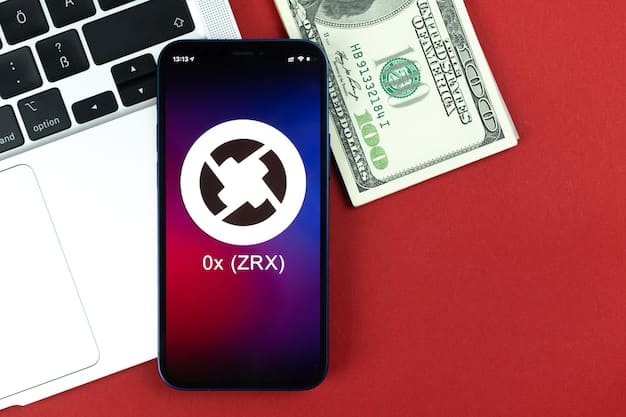Crypto Security: Protecting Your Assets from SIM Swapping in the US

SIM swapping in the US poses a significant threat to crypto security, allowing attackers to steal identities and access cryptocurrency accounts; understanding and mitigating these risks is essential for protecting your digital assets.
In today’s digital landscape, the security of cryptocurrency assets is paramount. One increasingly prevalent threat facing crypto users in the US is Crypto Security Alert: Understanding and Mitigating the Risks of SIM Swapping in the US. This article delves into the mechanics of SIM swapping, its implications for crypto security, and actionable strategies to protect yourself from this insidious attack.
What is SIM Swapping and How Does It Work?
SIM swapping, also known as SIM hijacking, is a type of identity theft where attackers trick mobile carriers into transferring your phone number to a SIM card they control. This allows them to intercept calls, SMS messages, and one-time passwords (OTPs) sent to your phone, effectively gaining access to your online accounts.
The process typically involves social engineering tactics to convince a mobile carrier representative that the attacker is the legitimate owner of the phone number. They might use information gleaned from data breaches, phishing scams, or even social media to impersonate you successfully.

The Mechanics of a SIM Swap Attack
Once the attacker controls your phone number, they can use it to reset passwords on various online accounts, including email, social media, and, crucially, cryptocurrency exchanges and wallets. The attacker requests a password reset, and the reset code is sent to the phone number they now control. This allows them to bypass two-factor authentication (2FA) methods that rely on SMS verification.
Why is SMS-Based 2FA a Vulnerability?
While 2FA adds an extra layer of security, SMS-based 2FA is increasingly recognized as a weak link. It assumes that the phone number is securely tied to the legitimate owner, but SIM swapping demonstrates how easily this assumption can be undermined. Attackers exploit the human element – the mobile carrier representative – to bypass the technical security measures.
Here are some ways SIM swapping works:
- Social Engineering: Attackers often pose as the victim, using stolen or publicly available information to convince mobile carrier employees to transfer the SIM.
- Insider Threats: In some cases, corrupt mobile carrier employees may be complicit in the SIM swap, transferring the number for a bribe.
- Phishing: Attackers may use phishing emails or websites to trick victims into providing their personal information, which is then used to facilitate the SIM swap.
In conclusion, understanding the vulnerability of SMS-based 2FA and the methods used in SIM swapping is the first step in protecting yourself. The next sections will discuss the specific ways in which SIM swapping impacts crypto security.
How SIM Swapping Impacts Crypto Security
The decentralized and often irreversible nature of cryptocurrency transactions makes them particularly vulnerable to SIM swapping attacks. Once an attacker gains access to your crypto accounts, they can quickly transfer funds to their own wallets, leaving little chance of recovery.
The impact of a successful SIM swap can be devastating, resulting in significant financial losses and a long, arduous process to recover your compromised accounts. Here’s a breakdown of how SIM swapping specifically targets crypto assets:
Gaining Access to Crypto Exchange Accounts
Most cryptocurrency exchanges rely on SMS-based 2FA for account security. A SIM swap allows attackers to bypass this security measure and gain full control of your exchange account. They can then withdraw your crypto holdings to their own wallets.
Compromising Crypto Wallets
Some crypto wallets also use SMS verification for recovery or secondary authentication. A SIM swap can allow attackers to gain access to these wallets, even if they don’t have the original seed phrase or private key. This is especially true for custodial wallets where a third party manages the private keys on your behalf.
Bypassing Account Recovery Processes
Even if an attacker doesn’t have immediate access to your crypto accounts, they can use the SIM-swapped phone number to initiate account recovery processes. By intercepting SMS codes, they can reset passwords and gain control of your accounts over time.
Listed are how sim swapping is impacting Crypto security:
- Immediate Financial Loss: Attackers can quickly transfer funds out of compromised crypto exchange accounts or wallets.
- Difficulty in Recovery: Cryptocurrency transactions are often irreversible, making it difficult to recover stolen funds.
- Reputational Damage: If your accounts are compromised, it can damage your reputation within the crypto community.

In short, SIM swapping presents a direct and significant threat to the security of cryptocurrency assets. It’s crucial to understand these risks to implement effective preventative measures before an attack occurs. The next section will provide practical steps you can take to protect yourself.
Practical Steps to Protect Yourself from SIM Swapping
While SIM swapping poses a serious threat, there are several steps you can take to significantly reduce your risk. These measures involve strengthening your overall security posture and making it more difficult for attackers to successfully impersonate you.
Proactive security measures will ensure you’re not an easy target. Let’s explore practical steps that can be taken today to reduce the risk of SIM swapping.
Strengthening Your Mobile Carrier Security
Contact your mobile carrier and request that they add extra security measures to your account. This might include a PIN or password that must be provided before any changes can be made to your SIM card. Ask them about their SIM swap policies and what steps they take to verify the identity of customers requesting SIM changes.
Using Authentication Apps Instead of SMS
Whenever possible, switch from SMS-based 2FA to authentication apps like Google Authenticator, Authy, or Microsoft Authenticator. These apps generate time-based one-time passwords (TOTP) that are not vulnerable to SIM swapping. They provide a more secure alternative because the codes are generated on your device and not transmitted over SMS.
Securing Your Personal Information
Be cautious about the information you share online, especially on social media. Attackers can use this information to impersonate you and convince mobile carriers that they are the legitimate owner of your phone number. Review your privacy settings on social media and limit the amount of personal information that is publicly available.
Here are tangible steps that can be taken:
- Enable PIN Protection: Request a PIN or password for SIM changes with your mobile carrier.
- Switch to Authentication Apps: Use apps like Google Authenticator for 2FA.
- Monitor Your Accounts: Regularly check your accounts for unauthorized activity.
- Use a Password Manager: Generate strong, unique passwords for each account and store them securely.
In conclusion, a combination of strong security practices and proactive communication with your mobile carrier can significantly reduce your vulnerability to SIM swapping. By understanding the threat and taking these steps, you can protect your crypto assets and maintain control over your digital identity.
Recognizing and Responding to a SIM Swapping Attack
Even with the best security measures, it’s crucial to be able to recognize the signs of a potential SIM swapping attack and respond quickly. Early detection and swift action can minimize the damage and prevent attackers from gaining access to your crypto accounts.
Recognizing the subtle signs is important to mitigate risks of possible SIM swapping attacks.
Signs of a Potential SIM Swap
One of the first signs of a SIM swap is a sudden loss of cellular service and the inability to make or receive calls or SMS messages. You might also notice that your 2FA codes are no longer working. Additionally, be wary of receiving unusual emails or phone calls requesting personal information or password resets.
Immediate Actions to Take
If you suspect that you are a victim of SIM swapping, contact your mobile carrier immediately to report the issue and regain control of your phone number and then immediately contact your bank to halt transfers or movement and ask them to freeze the account.
Also, change passwords for all of your accounts, especially those linked to your phone number, like email, social media, and crypto exchanges. Monitor your financial accounts and credit reports for any unauthorized activity.
Reporting the Incident
Consider reporting the incident to law enforcement, such as the Federal Trade Commission (FTC) or your local police department. This can help in the investigation and prosecution of the attackers. Document all relevant information, including the date and time of the incident, the mobile carrier representative you spoke with, and any unauthorized transactions.
- Loss of Cellular Service: Immediately suspect a SIM swap if you lose your phone service unexpectedly.
- Contact Your Mobile Carrier: Report the issue and regain control of your number.
- Change Passwords: Update all key accounts; banking, email, crypto exchanges.
In closing, quick recognition and immediate action are essential in minimizing the damage caused by a SIM swapping attack. Remaining calm and following these steps can help you regain control of your accounts and prevent further losses. Educating yourself and staying vigilant are your greatest allies in combating this threat. Do not give information to the person that’s giving you the first call because that might be the scammer in disguise.
Legal and Regulatory Landscape of SIM Swapping in the US
The increasing prevalence of SIM swapping has led to growing legal and regulatory scrutiny in the US. While there isn’t a specific federal law that directly addresses SIM swapping, various laws and regulations can be used to prosecute attackers.
Navigating the legal and regulatory landscape is another front in defense. Here’s some legal and regulatory information regarding the United States.
Relevant Laws and Regulations
Federal laws like the Computer Fraud and Abuse Act (CFAA) and the Identity Theft and Assumption Deterrence Act can be used to prosecute SIM swappers. Additionally, state laws often have specific provisions related to identity theft, fraud, and computer crimes that can be applied in these cases.
Mobile Carrier Liability
There is ongoing debate about the liability of mobile carriers in SIM swapping cases. Some victims have filed lawsuits against carriers, arguing that they failed to implement adequate security measures to prevent SIM swaps. The legal standards for carrier liability vary by state, and the outcomes of these cases often depend on the specific facts and circumstances.
Industry Efforts to Combat SIM Swapping
Mobile carriers and industry organizations are working on developing new security measures to combat SIM swapping. These include enhanced identity verification protocols, such as biometric authentication, and improved fraud detection systems. These efforts are aimed at making it more difficult for attackers to successfully impersonate customers and transfer SIM cards.
- Federal Laws: CFAA and Identity Theft Act can be used to prosecute SIM swappers.
- State Laws: Identity theft, fraud, and computer crimes can be helpful.
- Mobile Carrier Liability: Victims can file lawsuits against them for their security measures.
In sum, the legal and regulatory landscape surrounding SIM swapping is evolving as lawmakers and regulators grapple with the increasing threat. Greater awareness and enforcement of existing laws, coupled with industry efforts to improve security, are crucial in deterring and prosecuting SIM swapping attacks. Seek legal counsel or contact enforcement officers for related disputes.
The Future of Crypto Security and SIM Swapping Prevention
As technology evolves, so too will the methods used by attackers. The future of crypto security will likely involve more sophisticated authentication methods and a greater emphasis on decentralized identity solutions to mitigate the risks of SIM swapping and other forms of identity theft.
Forward-thinking strategies can keep you, the crypto community, one step ahead of the bad actors.
Emerging Authentication Methods
Biometric authentication, such as fingerprint scanning, facial recognition, and voice recognition, is becoming increasingly popular as a more secure alternative to SMS-based 2FA. Other emerging methods include hardware security keys, which provide a physical authentication factor that is difficult to compromise remotely.
Decentralized Identity Solutions
Decentralized identity (DID) solutions offer a way control digital identifiers and credentials without relying on centralized authorities. These solutions use blockchain technology to create tamper-proof digital identities that are more resistant to identity theft and fraud. Many DIDs use biometrics, but store them as hashes, which is more secure than a normal PIN or password.
Artificial Intelligence and Machine Learning
AI and machine learning technologies can be used to detect and prevent SIM swapping attacks. These systems can analyze patterns of phone usage and account activity to identify suspicious behavior and flag potential SIM swaps for investigation.
Listed are some future crypto security to watch out for:
- Biometric Authentication: Fingerprint scanning, facial recognition are useful.
- Decentralized Identity Solutions: Use blockchain to create tamper-proof digital identities.
- AI and Machine Learning: Analyze patterns for irregular behavior.
To conclude, the future of crypto security will depend on continuous innovation and adaptation. By embracing new authentication methods, exploring decentralized identity solutions, and leveraging the power of AI, we can create a more secure and resilient ecosystem that is better protected from SIM swapping and other emerging threats. Staying informed and adaptable is the key to defending the new landscape.
| Key Aspect | Brief Description |
|---|---|
| 📱 SIM Swapping | Attackers transfer your number, intercepting SMS 2FA codes. |
| 🔒 Security Measures | Use authentication apps, PIN protection, and monitor accounts. |
| 🚨 Incident Response | Report to carrier immediately, change passwords, and monitor activity. |
| 🛡️ Future Security | Biometrics, decentralized IDs, and AI for enhanced protection. |
Frequently Asked Questions
▼
SIM swapping is a kind of identity theft where criminals convince mobile providers to switch your phone number to a SIM card they control, allowing them to intercept SMS messages and bypass verification codes.
▼
To avoid SIM swapping, use authentication applications instead of SMS for 2FA, set up a PIN or password with your mobile provider, and be mindful of the personal data you disclose online to stop identity theft.
▼
If you believe you are a victim of SIM swapping, quickly contact your mobile provider to regain control of your phone number, change passwords to secure accounts to prevent further malicious actions.
▼
Some victims have sued mobile providers, but carrier responsibility ranges by state and conditions. Enhancing security can help stop SIM swaps in the legal setting because of growing concerns around responsibility.
▼
For improved authentication and identification management, technologies like biometrics, decentralized identities, and AI all provide higher security levels and lower the dangers of SIM swapping and identity theft.
Conclusion
Protecting your crypto assets from SIM swapping requires a multifaceted approach. By understanding the risks, strengthening your security measures, staying vigilant, and advocating for stronger industry standards, you can significantly reduce your vulnerability and safeguard your digital wealth. Vigilance and proactive measures are indispensable in the ever-evolving landscape of digital security.





